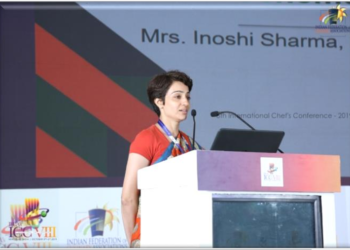THIS ARTICLE IS POWERED BY

Balasubramanian Swaminathan | IMAWS
Thanjavur: The inflation rate for consumers had moderated to 4.87 per cent in October 2023 and has picked pace again in November, marking the 50th month of staying above 4 per cent mark in the 4+/- 2 per cent band of medium-term inflation target set by the Reserve Bank of India (RBI).
While the Government of India has come up with announcements related to promoting millets across the country coming up with an international year of millets, much expectations evolved around consumption habits. Millets were the staples in India but gradually were relegated to the background and got marginalized post green revolution [GR] as the emphasis shifted to increased food grain production & productivity using high yielding varieties of wheat & rice in the identified GR geographies. KitchenHerald attempted to interact with few distributors across central Tamil Nadu to understand what would be the prediction on the food consumption habits.
Speaking on the key trends on food consumption, from a retail aspect, Gunaseelan Subramaniam aka Dinesh, who heads the retail sales in Punniamoorthi Pillai Department Store (PPDS) avers on the fact on recent times, there is a liking for traditional foods. However, according to him, it differs with tier 2 and 3 cities. “In these cities consumers have an inclination to try out cusines like pizza, burger, pasta,and more. There is also a huge transformation towards consumption of non-vegetarian foods.”, he says further adding that the time is far away where consumption habit moves completely towards traditional foods. PPDS is in the industry of selling food products for more for more than a century. An early entrant and who observes the market dynamics for generations after generations – from a small neighborhood shop to retail chains.
COVID was the game changer:
 The novel corona virus had brought tremendous change among the eating consumption habits. There is an overall opinion that the increase of awareness in the healthy food consumption had increased. However, on the other hand, there is a huge craze towards online ordering and eating ‘trendy food’. “There is an increase towards the demand for healthy options like oats for breakfast. However, what I can assure you all is there is also a room for traditional foods to come back”, says Abdul Aleem from Udhayam traders, Thanjavur. According to Mr Aleem, some forms of traditional oils which were selling 300 liters a month is getting sold at 3 tonnes. “My prediction is we should be prepared for more ‘back-to-the-root’ format foods. I am seeing the preference for ‘Mara Chekku Ennai’, oil which is grinded from seeds using traditional methods. We should not forget, there were a time consumers were preferring buying corn-flakes for breakfast. But that bubble had burst and idly and dosa had donned themselves as the undisputed king among the breakfast segments”, Aleem avers.
The novel corona virus had brought tremendous change among the eating consumption habits. There is an overall opinion that the increase of awareness in the healthy food consumption had increased. However, on the other hand, there is a huge craze towards online ordering and eating ‘trendy food’. “There is an increase towards the demand for healthy options like oats for breakfast. However, what I can assure you all is there is also a room for traditional foods to come back”, says Abdul Aleem from Udhayam traders, Thanjavur. According to Mr Aleem, some forms of traditional oils which were selling 300 liters a month is getting sold at 3 tonnes. “My prediction is we should be prepared for more ‘back-to-the-root’ format foods. I am seeing the preference for ‘Mara Chekku Ennai’, oil which is grinded from seeds using traditional methods. We should not forget, there were a time consumers were preferring buying corn-flakes for breakfast. But that bubble had burst and idly and dosa had donned themselves as the undisputed king among the breakfast segments”, Aleem avers.
Eco-system needs to be there:
Abdul Khader from AK Marketings, Thanjavur has a different view on traditional food. “Yes. I go agree there is a demand for traditional food formats. However, what I see is a lack of eco-system and infrastructure. Imagine an Indian manufacturer is coming up with super good food. As a distributor, my biggest challenge is to identify and source the foods. Even if I source, we find it tough to market them as most Indian food manufacturers fail to create awareness among the consumers.”, says Mr Abdul further adding that the cost of advertising in the mainstream media is also becoming a challenge for growing companies.
Another reason which Abdul says the maturity of traditional foods had not reached its fullest heights is the lack of standards. “For example, there are some quality standards like ISI or Hallmark or BSI which is on much trending. FSSAI is just a mere licence.
But we demand a quality council or a methodology to ensure the quality standards of the food under a single roof.” “So, in my opinion, the 2024 food industry will be no different than others but to an extent, we can expect some growth in preference towards traditional food. Another aspect might be a matter of concern is the increase in the preference of a ‘brand’ and peer-pressure in the food consumption.”
Packaged food might not survive:
 On the other hand, there was a steep raise in the curve towards consuming packaged food which ended up coming down again. “The curve was initially in the raise. However, even the millennial crowd does not find the packaged food tempting. There might be some who would be happy to try in the restaurant. However, on the long run, the packaged food is not finding future even in 2024. There were some companies that tried their luck in that. However they were not able to survive in the longrun”, said Senthil from Sri Thaila agencies.
On the other hand, there was a steep raise in the curve towards consuming packaged food which ended up coming down again. “The curve was initially in the raise. However, even the millennial crowd does not find the packaged food tempting. There might be some who would be happy to try in the restaurant. However, on the long run, the packaged food is not finding future even in 2024. There were some companies that tried their luck in that. However they were not able to survive in the longrun”, said Senthil from Sri Thaila agencies.
It has to be remembered that the retail inflation jumped to a three-month high of 5.55 per cent in November 2023, primarily due to a rise in food inflation, even as other components such as housing, clothing and footwear registered a moderation, data released by the National Statistical Office (NSO) showed.
Dinesh concluded telling that “Imparting the goodness of traditional food to customers is a tough task. However, it will slowly start evolving in every ones mind. In the year, 2024, food consumption outside home kitchen in tier 2 and 3 cities will be enormous.” Consumers have an urge towards tasting new varieties. However, after a point of time, they might easily get bored with reputative menu on their plate which will eventually make them try new foods often.”, Dinesh concluded.








